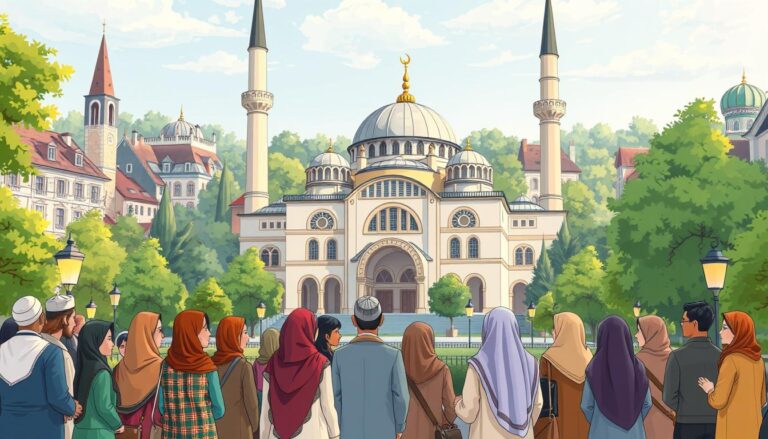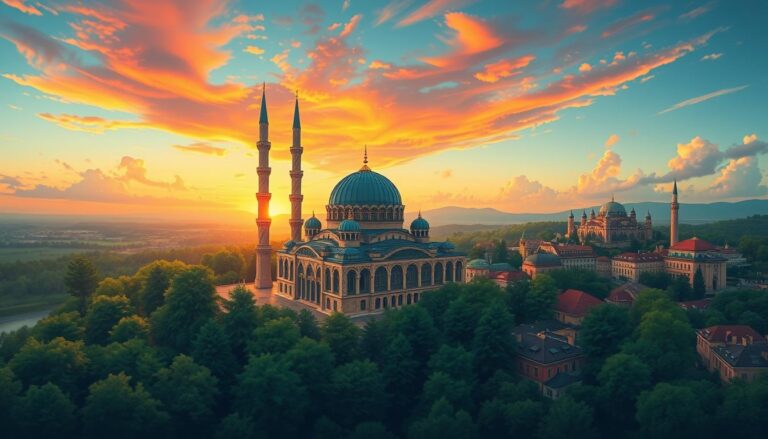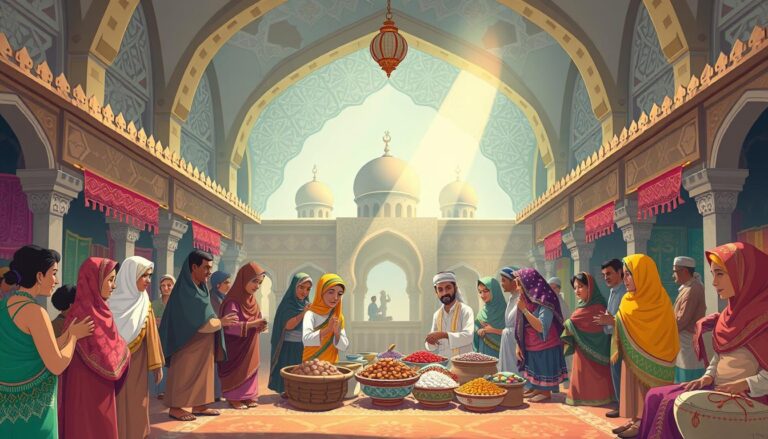Islam in South Korea
Nestled between the bustling metropolises of Seoul and Busan, a vibrant but little-known Muslim community thrives in South Korea. According to the Korea Muslim Federation, there are approximately 200,000 Muslims living in the country, with around 70 to 80 percent being foreigners. This diverse and growing population is shaping the cultural landscape of the predominantly Christian and Buddhist nation.
The Ministry of Foreign Affairs in South Korea has been at the forefront of recognizing and accommodating the Muslim community, hosting an Iftar dinner during the month of Ramadan every year since 2004. This gesture speaks to the government’s efforts to foster a more inclusive and understanding society, where minority faiths like Islam can find a home.
Key Takeaways
- There are approximately 200,000 Muslims living in South Korea, with the majority being foreigners.
- Seoul is home to 40% of South Korea’s total Muslim population.
- The South Korean government has hosted an annual Iftar dinner during Ramadan since 2004.
- Islam has had a presence in the Korean Peninsula since the 9th century, with Muslim traders and settlers establishing contact with the Silla kingdom.
- The spread of Islam in Korea in the modern era accelerated after World War II and the establishment of the Korean Muslims Society in 1955.
Historical Origins of Islam in Korea
The earliest verifiable presence of Islam in Korea dates back to the 9th century during the Unified Silla period, when Arab navigators and traders first arrived. Muslim geographers, including the 9th-century explorer Ibn Khordadbeh, reported that many of these early Muslim settlers established permanent communities in Korea. Records indicate that a significant number of these settlers were from Iraq, and Korean sources suggest that a large group of Muslim foreigners settled in Korea in the 9th century CE, led by a man named Hasan Raza.
Interestingly, figurines of royal guardians with distinctly Persian characteristics have been discovered, further suggesting the existence of a Middle Eastern Muslim community in the Silla kingdom. This early Islamic presence in Korea during the Silla period provides a fascinating glimpse into the Muslim traders and settlers who made their way to the Korean Peninsula in the centuries before the Goryeo and Joseon dynasties.
“The earliest verifiable presence of Islam in Korea dates back to the 9th century during the Unified Silla period, when Arab navigators and traders first arrived.”
Goryeo Dynasty and Mongol Influence
During the Goryeo dynasty, trading relations between the Islamic world and the Korean peninsula continued to flourish. A number of Muslim traders from the Near East and Central Asia settled down in Korea, establishing families and integrating into the local society. This period also saw the arrival of the so-called Saengmogin, a group of Central Asian Muslims, with the Mongol armies.
In the Mongol social order, the Saengmogin occupied a position just below the Mongols themselves, and they exerted a significant influence within the Yuan dynasty. One of these Central Asian immigrants, Jang Sunnyong, became the founding ancestor of the Deoksu Jang clan, which produced many high-ranking officials and respected Confucian scholars over the centuries.
Arrival of Central Asian Muslims
The Goryeo dynasty, which ruled Korea from 918 to 1392, was a center of trade and industry, with the capital in modern-day Kaesong serving as a hub for commerce. During this time, the kingdom maintained close trading relations with the Islamic world, and a number of Muslim traders and settlers from Central Asia made their way to the Korean peninsula.
With the Mongol invasion and the subsequent establishment of the Yuan dynasty’s control over Goryeo, the presence of Central Asian Muslims in Korea increased further. These immigrants, known as the Saengmogin, held influential positions in the Mongol social hierarchy, just below the Mongols themselves. Their arrival and integration had a lasting impact on the cultural and religious landscape of the Goryeo dynasty.
“The Goryeo dynasty in Korea (918-1392) saw significant settlement of Muslims who were assimilated into Korean society.”
Assimilation and Decline
Over the centuries, the assimilation of Islam in Korea took place as many Muslims intermarried with Koreans. Due to Korea’s geographical isolation from the Muslim world, some even assimilated into Buddhism and Shamanism, the predominant religious practices in the region. By the 16th century, Islam was practically non-existent in Korea, though memories and a minor Islamic presence persisted until the 19th century and beyond.
Unfortunately, it is believed that many of the religious practices and teachings of Islam did not survive the prolonged isolation and assimilation process in Korea. The decline of Islam in Korea can be attributed to these factors, as the faith struggled to maintain its foothold in the face of cultural and religious integration.
“The assimilation of Islam in Korea was a gradual process, with many Muslims adopting local customs and beliefs over time. This led to the near-disappearance of the religion by the 16th century.”
While the religious practices in Korea evolved, the legacy of Islam’s presence in the region lived on in the form of memories and a small continued presence. This period marked a significant transition for the Muslim community in Korea, as the faith adapted to the local cultural landscape.
Islam in South Korea
Turkish Brigade During the Korean War
Islam was reintroduced to the Korean Peninsula in a more structured way during the 20th century. One pivotal moment was the Korean War, when Turkey sent a significant contingent of troops, known as the Turkish Brigade, to aid South Korea under the United Nations command. These Turkish Muslim soldiers not only contributed to the war effort on the battlefield but also helped to reintroduce Islam to the region.
The presence of the Turkish Brigade exposed the Korean people to Islamic faith and culture, contributing to the gradual reemergence of Islam in the country. While the Muslim population in South Korea remains relatively small, accounting for just 0.38% of the total population, the impact of the Turkish Brigade’s deployment during the war has been lasting.
Today, the Muslim community in South Korea is estimated to be around 200,000 strong, with a significant portion being foreign nationals, primarily migrant workers and international students. The reintroduction of Islam during the Korean War has been a significant factor in the growth and evolution of this community, shaping its religious and cultural landscape.
“The presence of the Turkish Muslim soldiers during the Korean War helped to reintroduce Islam to the Korean Peninsula, paving the way for the gradual growth of the Muslim community in South Korea.”
Modern Muslim Community in South Korea
The modern Muslim community in South Korea is a diverse and thriving group, centered primarily in the cities of Seoul and Busan. With an estimated 250,000 Muslims out of a population of around 51 million, the Muslim population in South Korea has quadrupled since 1994, thanks to an influx of foreign university students and intermarriages with Koreans.
The Muslim community in South Korea is a mix of ethnic Koreans and foreign-born individuals, with up to 75,000 Korean Muslims and 150,000 foreign-born Muslims. While Muslims make up less than 0.5% of the total population, their presence and contribution to the country’s cultural fabric are undeniable.
Across South Korea, there are around 15 mosques and 60 Islamic centers, serving as hubs for the Muslim community. The Seoul Central Mosque, opened in 1976, is the first mosque in the country and a significant gathering place for Muslims and non-Muslims alike.
As South Korea becomes more open to Muslim visitors, the country has increased the number of Halal certifications for its restaurants and prayer rooms. The Seoul Tourism Organization is also actively promoting Muslim-friendly attractions, catering to the growing needs of the global Muslim traveler.
The Muslim community in South Korea is actively working to bridge the gap between Korean culture and Islamic traditions, challenging common mainstream media portrayals of Islam. Through their social activities, charity programs, and efforts to create a welcoming environment, the Muslim community in South Korea is making strides in fostering understanding and coexistence.
“The Muslim community in Incheon demonstrates a spirit of solidarity and unity through ukhuwah islamiyah, wathoniyah, and insaniyah. They welcome strangers, help those in need, and aim to create a welcoming environment for everyone.”
Challenges and Integration
The Muslim community in South Korea faces significant challenges in integrating into the predominantly Christian and Confucian society. Cultural differences, such as the strong drinking culture and class hierarchy, have posed barriers for many Muslims seeking to establish a foothold in this East Asian nation.
Discrimination and Islamophobia have also been persistent issues. The construction of a mosque in Daegu, for instance, has become a flashpoint, with local residents filing petitions and using hate speech, including the display of severed pig heads, to oppose the project. This incident highlights the need for stronger anti-discrimination legislation in South Korea to protect the rights of religious minorities.
Navigating Cultural Differences
The Muslim community in South Korea must navigate a complex cultural landscape that can be vastly different from their own. The strong emphasis on drinking and class hierarchy, which are deeply rooted in Korean society, can create challenges for Muslims trying to find their place. Adapting to these cultural norms while maintaining their religious identity can be a delicate balancing act.
According to estimates, the Muslim population in South Korea stands at under 200,000, representing roughly 0.4% of the total population. With a growing number of foreign residents and asylum seekers, the need for greater cultural integration and understanding has become increasingly pressing.
“The global Muslim population is growing, making Muslims the world’s fastest-growing religious group. In South Korea, however, Muslims make up less than 1% of the country’s total population, with Protestantism being the largest religious group at 14%.”
As South Korea seeks to address labor shortages and attract workers and students from other countries, the integration of religious and cultural minorities will be crucial for fostering a more inclusive and diverse society.
Islam in South Korea
The Muslim community in South Korea continues to evolve and adapt to the local culture, despite the challenges it has faced. This diverse community includes both foreign nationals and native Korean Muslims, who strive to balance their Korean identity with their Islamic faith. The government has made efforts to accommodate the Muslim population, such as hosting Iftar dinners during Ramadan, but more work is needed to foster greater understanding and acceptance of Islam in the country.
According to recent statistics, the number of Muslims in South Korea is estimated to be around 200,000, representing approximately 0.4% of the country’s total population. This Muslim population includes a significant number of foreign residents, which accounted for around 168,000 individuals in 2016, as well as a growing community of native Korean Muslims, estimated at around 35,000.
While the Muslim community in South Korea remains relatively small compared to the country’s dominant Christian population, with over 30,000 Protestant churches, the number of mosques has gradually increased over the years. Currently, South Korea has around eight mosques, including the prominent Seoul Central Mosque, which has seen a 10-fold increase in visitors over the past decade, reaching a peak of 2,500 visitors last year.
The presence of Muslims in South Korea has also had an impact on the country’s commercial and tourism sectors. The value of construction contracts won by South Korean companies in the Middle East, for instance, has grown from $750 million in 1975 to $8.2 billion in 1980. Additionally, South Korea aims to attract 1.2 million Muslim visitors annually, with a record 971,649 Muslim tourists visiting the country in the previous year, marking an 11% increase from the year before.
Despite these developments, challenges remain in terms of integrating the Muslim community into Korean society. According to a 2018 survey by the Korea Tourism Organization, 34% of Muslim tourists in South Korea indicated that food was their biggest inconvenience, highlighting the need for more halal-certified restaurants and facilities to accommodate the growing Muslim population.
“Indeed, Allah commands justice, the doing of good, and giving to kith and kin, and He forbids all indecent deeds, and evil and oppression: He instructs you, that you may receive admonition.” (Quran 16:90)
As the Muslim community in South Korea continues to grow, the government and society must work together to foster greater understanding and acceptance of Islam, ensuring that the country’s religious diversity is celebrated and celebrated.
Legal and Policy Efforts
South Korea’s journey towards greater religious tolerance has faced challenges, particularly in the realm of anti-discrimination legislation. The country has made several attempts to enact comprehensive laws prohibiting discrimination based on factors such as religion, but these efforts have been met with opposition from conservative Protestant groups.
The lack of clear legal guidelines and enforcement mechanisms has made it difficult to address incidents of hate speech and discrimination against the Muslim community. This was evident in the Daegu mosque case, where the National Human Rights Commission of Korea recognized the residents’ actions as hate speech, but its intervention was limited to making recommendations.
Experts argue that South Korea needs to strengthen its legal framework to protect the rights of religious minorities and promote greater religious tolerance in the country. The government’s policies towards religious minorities have come under scrutiny, with calls for more effective anti-discrimination legislation in South Korea.
“The lack of clear legal guidelines and enforcement mechanisms has made it difficult to address incidents of hate speech and discrimination against the Muslim community.”
While progress has been slow, there are signs of hope. The government has recognized the importance of fostering a more inclusive society and has taken steps to address the challenges faced by religious minorities. However, much work remains to be done to ensure that all South Koreans, regardless of their religious beliefs, can live in a climate of mutual understanding and respect.
As South Korea continues to grapple with these complex issues, the path towards greater religious tolerance will require a multifaceted approach that addresses the legal, social, and cultural barriers that have hindered progress thus far. Only through sustained efforts and a genuine commitment to diversity and inclusion can the country truly achieve its aspirations of becoming a more just and equitable society.
International Students and Diversity
South Korean universities are witnessing a surge in the number of foreign students, including a growing population of Muslim international students. The influx of these students is seen as a valuable asset as the country grapples with a declining domestic student enrollment.
Figures show that the number of foreign national students enrolled in Korean colleges and universities has surpassed 200,000, with significant representation from Muslim-majority countries like Pakistan, Uzbekistan, and Bangladesh. This diversity has brought new perspectives and cultural exchanges to campuses across South Korea.
However, the challenges faced by the Muslim community at Kyungpook National University (KNU), such as the mosque construction dispute, highlight the need for greater efforts to foster understanding and integration of diverse religious and cultural communities in the country. Despite the presence of international covenants and South Korea’s constitution banning discrimination, the lack of a specific anti-discrimination law in the country has made it difficult to address issues faced by foreign students in South Korea and Muslim international students.
The diversity in South Korean universities is a testament to the country’s growing global connections, but it also underscores the importance of creating an inclusive environment that celebrates and supports the unique needs and experiences of all students, regardless of their backgrounds.
“Diversity is not about how we differ. Diversity is about embracing one another’s uniqueness.” – Ola Joseph
As South Korea continues to attract more foreign students in South Korea and Muslim international students, it is crucial that policymakers, university administrators, and the broader community work together to foster a culture of acceptance and understanding. By embracing the richness that diverse perspectives bring, South Korea can truly become a global hub of learning and innovation.
Fostering Understanding and Coexistence
As South Korea becomes increasingly diverse, there is a pressing need to foster greater understanding and coexistence between different religious and cultural communities. Experts argue that the country must strengthen its legal framework to protect the rights of religious minorities and promote interfaith dialogue in South Korea, moving beyond the current lack of clear guidelines and enforcement mechanisms.
Initiatives such as promoting religious tolerance through educational programs and diversity and inclusion policies can help bridge the gaps and promote mutual respect and understanding between the Muslim community and the broader Korean society. The annual “2024 Iftar Dinner” in Seoul, for instance, has grown from around 20 participants in 2004 to nearly 200 guests, showcasing the growing connections between Korea and the Muslim world.
The presence of business and religious leaders, scholars, students, journalists, TV personalities, and social media influencers at the Iftar Dinner highlights the broad connections between Korea and the Muslim community. This event serves as an opportunity to spread universal values of religious solidarity and tolerance, fostering understanding and coexistence between Korea, Arab, and Islamic countries.
“The historical ties between Korea and the Muslim community date back to the 9th century, indicating a long-standing affinity between the two communities. Muslim soldiers made significant contributions during the Korean War and subsequent economic cooperation in the 1970s fueled Korea’s growth, illustrating a historical connection between Korea and Muslim nations.”
As South Korea continues to diversify, it is crucial to strengthen legal protections, promote educational initiatives, and create inclusive policies that celebrate the country’s religious and cultural diversity. By fostering understanding and coexistence, South Korea can become a shining example of a harmonious, multi-faith society.
Conclusion
The story of Islam in South Korea is one of resilience, adaptation, and growing diversity. From the early connections in the 7th century to the establishment of the first Islamic organization in 1955, the Muslim community in South Korea has navigated a complex historical journey marked by both integration and challenges.
Today, the Muslim population in South Korea has grown significantly, with both foreign and native Korean Muslims contributing to a vibrant and dynamic community. However, the community continues to face obstacles in fully integrating into the predominantly Christian and Confucian society, including cultural differences, discrimination, and the lack of comprehensive anti-discrimination legislation.
As South Korea becomes increasingly diverse, it is crucial to foster greater understanding and coexistence between different religious and cultural communities. Through legal reforms, educational initiatives, and policies that promote inclusion and tolerance, the country can ensure that the Muslim community, along with other minority groups, can thrive and contribute to the nation’s rich tapestry of diversity.
Source Links
- Islam in Korea
- Did you know?: Muslim Presence in the Korean Peninsula
- South Korean Muslims – İnsamer – İnsamer
- Korea Information – History — Korean Cultural Center New York
- The Rise of Korean Islam: Migration and Da‘wa
- 1,500 Years of Contact between Korea and the Middle East
- Goryeo
- 7(JANG Dong-Jin)
- Islamophobia in South Korea with a focus on Muslim migrants
- ‘Many Koreans have big misunderstandings about Islam,’ says a Muslim convert in South Korea
- South Korea – United States Department of State
- Korea: A Land of Few Muslims – The Islamic Monthly
- Amazed by the Strong Islamic Unity among South KoreanMuslims
- Being Muslim and Korean – A Combination That Surprises Many | About Islam
- Scholar calls for better integration of Korea’s Muslims
- What It Feels Like to be Muslims in Korea
- How Influential Is Islam in South Korea?
- The official website of the Republic of Korea
- Young Muslims become flag-bearers of Islam in South Korea via social media
- Muslims in South Korea want to build a mosque. Neighbors protest and send pig heads
- Mosque project tests South Korea’s tolerance for increasing diversity
- Muslims Abroad: Rutgers Grad Creates Guide to Navigating Identity While Studying Abroad
- Global Islamic Consumerism and Local Reactions: The Emergence of South Korea’s Halal Industry and Islamophobic Responses – Maydan
- Religions
- Korea celebrates growing ties with Muslim community during Ramadan
- BAKS 16 Niu, Islam and SK.pages







